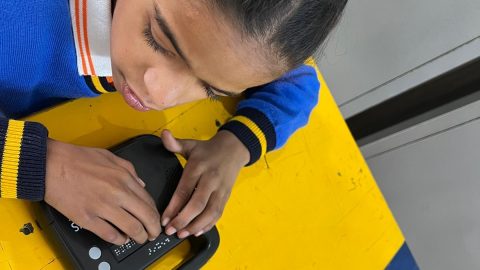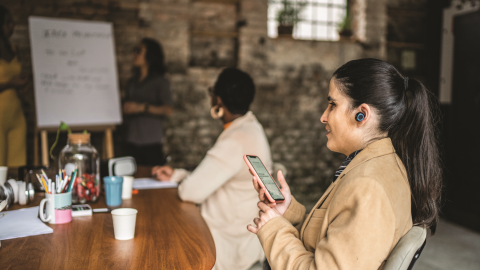Satya Nadella, Microsoft CEO: “The moment that forever changed our lives.”
Today, Microsoft CEO Satya Nadella shares his personal journey with accessibility with an essay on LinkedIn. You can find the full text below with links to audio descriptive videos here.
I remember the year 1996 as a thrilling time. My wife, Anu, was 25 and I was 29. My career as an engineer was taking off, while she was building her career as an architect. We were far from our families in India, but settling into our new life together in the Seattle area. Even more exciting, however, was that Anu was pregnant with our first child. In the apartment we were renting next to the Microsoft campus, we spent months busily preparing for his arrival – — decorating a nursery, putting plans in place for Anu to return to her career, envisioning how our weekends and holidays would change …. We were ready to add a new joy to our life.
But then our plans changed.
One night, during the thirty-sixth week of her pregnancy, Anu noticed that the baby was not moving as much as she was accustomed to. So we went to the emergency room of a local hospital in Bellevue. We thought it would be just a routine checkup, little more than new parent anxiety. In fact, I distinctly remember feeling annoyed by the wait times we experienced in the emergency room. But upon examination, the doctors were alarmed enough to order an emergency cesarean section. Zain was born at 11:29 p.m. on August 13, 1996, all of three pounds. He did not cry.
Zain was transported from the hospital in Bellevue across Lake Washington to Seattle Children’s Hospital with its state- of- the- art Neonatal Intensive Care Unit. Anu began her recovery from the difficult birth. I spent the night with her in the hospital and immediately went to see Zain the next morning. Little did I know then how profoundly our lives would change. Over the course of the next couple of years we learned more about the damage caused by in utero asphyxiation, and how Zain would require a wheelchair and be reliant on us because of severe cerebral palsy. I was devastated. But mostly I was sad for how things turned out for me and Anu.
(Excerpt from his book, Hit Refresh.)
To say that period of time was difficult is an understatement. One of the things I remember most clearly, however, is how Anu’s reaction to Zain’s birth was immediately so different from mine. For Anu, it was never about what this meant for her — it was always about what it meant for Zain and how we could best care for him. Rather than asking “why us?” she instinctually felt his pain before her own.
Watching her in those first few days, weeks and beyond taught me a lot. Over time, Anu helped me understand that nothing had happened to me or to her, but something had happened to Zain. As his parents, it was up to us not to question “why,” but instead to do everything we could to improve his life. Anu is an amazing woman, mother and partner. Her empathy for others runs deep, and from her I have learned the power of infusing empathy into my everyday actions, whether they be in my role as a father or as a CEO. She inspires me with her willingness to share more about her journey as a mom in the hope it can help others.
Becoming a father of a son with special needs was the turning point in my life that has shaped who I am today. It has helped me better understand the journey of people with disabilities. It has shaped my personal passion for and philosophy of connecting new ideas to empathy for others. And it is why I am deeply committed to pushing the bounds on what love and compassion combined with human ingenuity and passion to have impact can accomplish with my colleagues at Microsoft.
It is fitting that the theme of this year’s U.S. National Disability Employment Awareness Month — recognized every October — is “Inclusion drives innovation.” We could not agree more. At Microsoft, we are making accessibility a top priority in our product development efforts, from core features in Windows 10 like Narrator to pushing the boundaries of what’s possible through innovations like Hearing AI created by Azure engineer Swetha Machanavajhala. In addition, we know that having an employee base that is representative of all backgrounds and abilities is one of our greatest strengths. This is why we continue to be passionate about hiring people with disabilities through initiatives like the Autism Hiring Program and Supported Employment Program, which help us advance our mission to empower every person on the planet — including more than 1 billion people who have disabilities.
An audio descriptive version of the Autism Hiring Video available.
I am an optimist who firmly believes that at its most powerful, technology can contribute to incredible human capability and insight. I also believe it can help people find immense joy and a deeper connection to the world around them by enabling them to realize their professional and personal potentials. Some of my favorite examples of technology in action are where people have come together from across Microsoft, united by a shared passion to hack and build solutions that have the potential to benefit millions:
- Eye Control: The new Eye Control feature in Windows 10 began as a passion project from our first and now annual OneWeek Hackathon. Inspired by a challenge from former NFL player Steve Gleason in 2014, who has a neuromuscular disease called amyotrophic lateral sclerosis (ALS), the hackathon team produced the first Eye Gaze Wheelchair, which allowed Steve to drive his wheelchair with only the movement of his eyes as he looked at controls on his Surface. Fast-forward three years, thanks to the work of many across the company, Eye Control now makes Windows 10 more accessible by empowering people with disabilities to operate an onscreen mouse, keyboard and text-to-speech experience using only their eyes and a compatible eye tracker like the Tobii 4C. Even better, this was one of several new accessibility features announced this week by the Windows team as part of the Windows 10 Fall Creators Update.
An audio descriptive version of the Eye Control video available.
- Seeing AI: Recently, one of my colleagues, Angela Mills, shared her personal story with me. Angela is visually impaired — having lost her central vision when she was a child, today she has only her peripheral vision. Over the years, she has used various technologies to assist her daily activities, but she calls the early release of the new Seeing AI app “life-changing.” Before, when she went into a cafeteria for lunch, she would have to find a cafeteria worker and ask for help picking out a salad. Now, she can go to the salad area and use the app on her phone to read the labels of the salads before choosing one by herself. She can walk confidently into a conference room, knowing for sure she’s in the right place with the right people; and when she’s cooking at home, she doesn’t have to rely on her husband to read out the labels on the spice jars. It’s incredible to see how this idea that was sparked and developed at our annual hackathon by Saqib Shaikh, Anirudh Koul and team, is now a free application that enables Angela and many others to feel more included and connected to the world around them, and we can’t wait to bring it to more folks around the world in weeks and months to come.
- Learning Tools: Another Hackathon project brought an incredible team of individuals together from across Microsoft in the U.S. and Canada to focus on technology for children with dyslexia. The team leveraged complex academic research on reading rates and translated it into technology, and built a simple set of experiences with big impact. The Office and Windows teams embraced the thinking and Learning Tools in addition to being an add-in for OneNote, is now built into Word and Outlook online and Microsoft Edge. Learning Tools was initially designed to improve the reading and writing experience for dyslexic students. But by leveraging a variety of existing technologies like Bing’s speech recognition, simultaneous audio text playback and natural language processing, it actually makes reading and writing more accessible to all students. What I especially love is that it is truly an example of inclusive design — a one-size-fits-all solution that can work for a full spectrum of diverse users.
An audio descriptive version of the Learning Tools video is available.
These are just a few examples of the power of inclusive design — it goes beyond any one product or feature. Inclusive teams that propagate and advance inclusive principles will have the deepest impact in building products designed for everyone. Consider that at some point in our lives, each of us may rely on assistive technologies.
Our work in accessibility has an incredibly deep meaning to me personally. Our family’s experience has required me to continually hit refresh on my emotions and on my outlook, and it is in this constant quest for renewal that I realize — despite the fact we are making progress — we still have much to do, quickly, for so many.
But Zain reminds me that we can get there. He is the joy of our family, whose strength and warmth both inspire and motivate me to keep pushing the boundaries of what technology can do. And I’ve found that the moments that so deeply change our lives can also be a catalyst to empower those around us. This is what I see in the scores of passionate people at Microsoft. My hope is that we can collectively work together to amplify this across the planet.
This article by Microsoft CEO, Satya Nadella, originally appeared on his LinkedIn.







